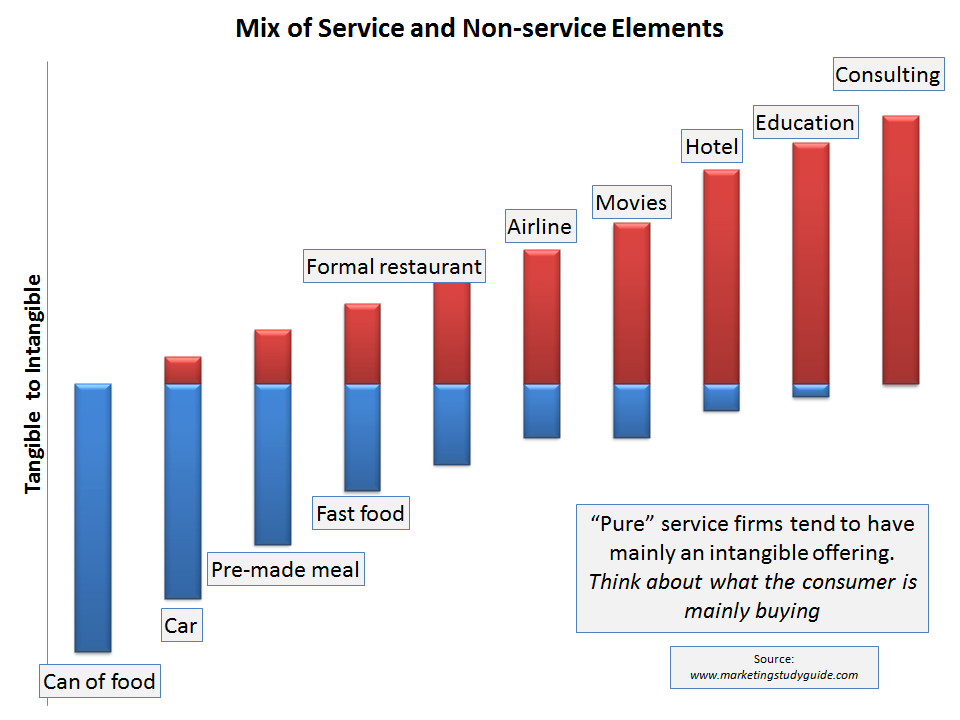Using and Understanding the Intangibility Continuum
Essentially all product offerings in the marketplace are a mix of services and goods – that is, intangible and tangible elements. This was first documented by Lynn Shostack in 1977 in a journal article published in the Journal of Marketing (Breaking Free from Product Marketing). (Note: It is at a cost via this journal site, but you may be able to access for free through a university library.)
Virtually all industries have a product offering that is a mix of both tangible and intangible elements

In the following diagram, the blue color refers to the extent of tangible/physical product offering and the red is the extent of intangible/service product offering across a number of selected industries.
What the tangibility-intangibility continuum tells us
- Virtually all industries have a product offering that is a mix of both tangible and intangible elements,
- Some firms/industries tend to have a greater extent of intangible (that is, service) components in their overall offerings,
- When we study Services Marketing, we are primarily concerned with the type of firms/industries on the right hand side of the graph (in this case: education, consulting, hospitality – and of course, banking and insurance, medical services would be there too),
- Note: The firms on the far right hand side are sometimes referred to as “pure” service providers, and
- There is a difference between being a service provider and selling a physical/tangible product that is packaged with customer service.
Industry/Product | Tangible or Intangible? | Rationale |
Can of food | Tangible | The consumer is simply a physical product without any expectation of additional service |
Car | Tangible | The consumer is primarily receiving tangible product, however the manufacturer may package the offering with some intangible elements, such as: finance, free servicing and a warranty period |
Pre-made meal | Tangible | This is similar to the above example of the can of food, but also contains an intangible element – in this case the product has moved beyond simply a basic ingredient to be a mixed offering of food items that can be quickly and easily prepared as a meal. Therefore, the preparation provided can be considered an element of service |
Fast food | Mixed | Most textbooks will describe a fast food (or quick serve) outlet as having a balanced mix of tangible and intangible elements. The various menu items are clearly tangible and the intangible elements are the use of the facilities (that is, seating, rest rooms, and playground) as well as the actual customer service provided |
Formal restaurant | Mixed | The next level up the intangibility continuum would be a formal (fine dining) restaurant. Like a fast food chain, they also provide tangible food and drink; however they package their offering with high levels of customer service, special orders, and high quality facilities and so on |
Airline | Intangible | Airlines primarily deliver intangible benefits – essentially the physical movement of people, luggage and goods. They have some tangible offerings as well, usually food and beverages served on the flight |
Movies | Intangible | Movies/cinemas are similar to airlines above, where the prime offering is intangible (entertainment, great viewing experience, comfortable facilities), as well as some tangible elements of snacks, drinks and even souvenirs, toys and 3D glasses |
Hotel | Intangible | Hotels and associated hospitality providers are highly intangible in their offerings. Consumers have use of a room, the hotel’s facilities and possible entertainment. Like the food businesses above, they will also tangible meal solutions |
Education/Consulting | Intangible | At the top end of the continuum are industries such as education, professional service firms, banking and insurance. They can be considered “pure” service firms as they do not tend to offer anything tangible elements (other than a book or a report, for example, from a consulting firm |
